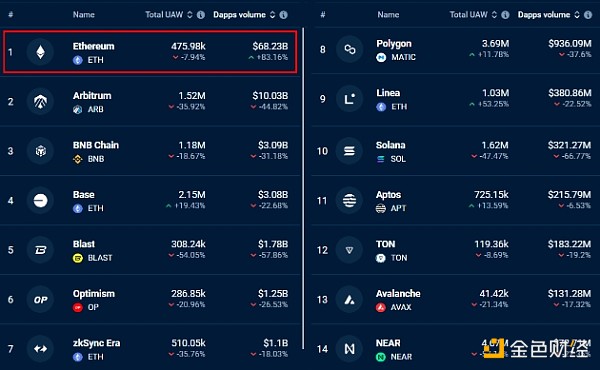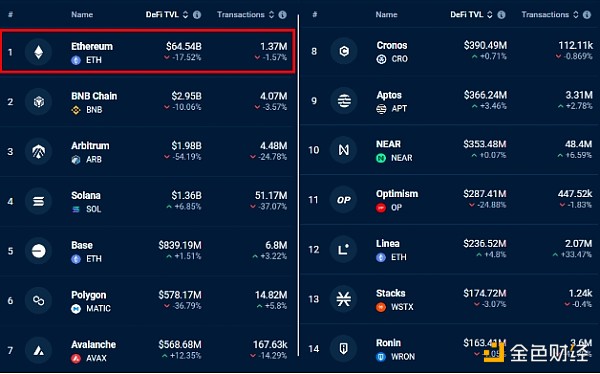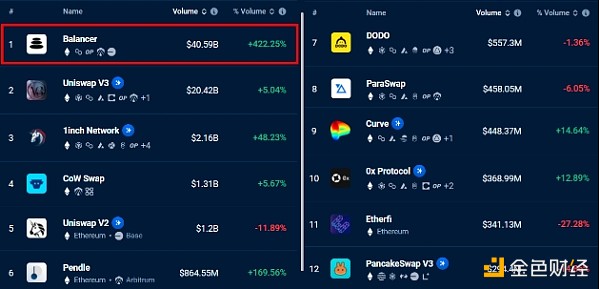Author: Marcel Pechman, CoinTelegraph; Compiler: Deng Tong, Golden Finance
The Ethereum network continues to lead the adoption of decentralized applications (DApps) in terms of transaction volume and deposits. Although competitors like Solana and BNB Chain benefit from lower transaction fees, which boost metrics such as unique active addresses, there is nothing to stop well-funded entities from exaggerating Ethereum's DApp numbers.
In fact, the recent surge in activity on the Ethereum network is different from the broader cryptocurrency market trends and even contradicts other usage indicators.While it is impossible to confirm any manipulation, people should be aware that even with transaction fees as high as $2.4, the numbers may be distorted, especially in decentralized finance (DeFi) applications, where deposits may exceed $1 billion.

Top blockchains by 7-day DApp transaction volume (in USD). Source: DappRadar
Notably, Ethereum was the only network in the top 20 to report an increase in transaction volume, up an impressive 83% compared to the previous week. Similar protocols such as BNB Chain, Polygon, Solana, and TON saw average transaction volumes drop by more than 30%. Furthermore, Ethereum’s 475,980 addresses pale in comparison to BNB Chain’s 1.18 million and Solana’s 1.62 million.
Notably, the surge in Ethereum’s transaction volume has not been matched by an increase in the number of users. Using unique active addresses interacting with DApps as a metric, Ethereum’s number of users decreased by 8% from the previous week, which is better than its competitors but contradictory given its large increase in transaction volume.
One might argue that despite having fewer users due to relatively high fees, the growth in Ethereum deposits may have offset the decrease in activity.

Top blockchains by total value locked in DeFi (in USD). Source: DappRadar
Data shows that the total value locked in Ethereum DeFi applications fell by 17.5% in 7 days, while competitors such as Solana and Avalanche successfully attracted deposits. During this period, the number of DApp transactions on the Ethereum network did not increase, indicating that a more thorough analysis is needed to understand the anomaly.

Top Ethereum DApps by 7-day transaction volume (USD). Source: DappRadar
Ethereum transaction volume growth was mainly driven by Balancer's 422% increase in 7 days, totaling $40.6 billion.For example, this is 13 times the total on-chain activity of BNB in the same period. However, Balancer’s notable growth in transaction volume did not sync with improvements in other metrics; the DApp saw a 5% decrease in unique addresses and a 14% decrease in transaction volume in the same week.
Excluding Balancer’s contribution, Ethereum’s seven-day transaction growth was actually down 5% as this single DApp accounted for 59.5% of the entire network’s transaction volume. While it’s not uncommon for a single DApp to dominate a blockchain’s transaction volume — the BNB chain is primarily driven by PancakeSwap, while Uniswap has a nearly 50% share on the Polygon Network — Ethereum’s reported growth in activity should be viewed with caution as a single DApp is skewing the data.
Determining the true demand behind the surge in Balancer trading volume is challenging. Even if some transactions within the DApp are marginally profitable, this does not conclusively determine user intent. For example, Binance exchange announced on July 1 that the Balancer (BAL) token was on a watch list for potential delisting, which may be related to the DApp's unusual activity, although establishing a direct link between the two events is complicated.
 JinseFinance
JinseFinance








